The AMD Ryzen Threadripper 3960X and 3970X Review: 24 and 32 Cores on 7nm
by Dr. Ian Cutress, Andrei Frumusanu & Gavin Bonshor on November 25, 2019 9:05 AM ESTCPU Performance: System Tests
Our System Test section focuses significantly on real-world testing, user experience, with a slight nod to throughput. In this section we cover application loading time, image processing, simple scientific physics, emulation, neural simulation, optimized compute, and 3D model development, with a combination of readily available and custom software. For some of these tests, the bigger suites such as PCMark do cover them (we publish those values in our office section), although multiple perspectives is always beneficial. In all our tests we will explain in-depth what is being tested, and how we are testing.
All of our benchmark results can also be found in our benchmark engine, Bench.
Application Load: GIMP 2.10.4
One of the most important aspects about user experience and workflow is how fast does a system respond. A good test of this is to see how long it takes for an application to load. Most applications these days, when on an SSD, load fairly instantly, however some office tools require asset pre-loading before being available. Most operating systems employ caching as well, so when certain software is loaded repeatedly (web browser, office tools), then can be initialized much quicker.
In our last suite, we tested how long it took to load a large PDF in Adobe Acrobat. Unfortunately this test was a nightmare to program for, and didn’t transfer over to Win10 RS3 easily. In the meantime we discovered an application that can automate this test, and we put it up against GIMP, a popular free open-source online photo editing tool, and the major alternative to Adobe Photoshop. We set it to load a large 50MB design template, and perform the load 10 times with 10 seconds in-between each. Due to caching, the first 3-5 results are often slower than the rest, and time to cache can be inconsistent, we take the average of the last five results to show CPU processing on cached loading.
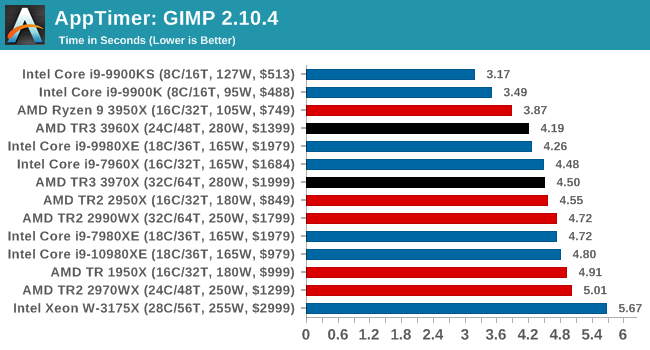
Onto our single threaded tests, and the mainstream hardware with high single thread frequencies wins here, but the 3960X is leading the rest of the pack. Intel's 28-core part here sits last, behind even the 1950X.
3D Particle Movement v2.1: Brownian Motion
Our 3DPM test is a custom built benchmark designed to simulate six different particle movement algorithms of points in a 3D space. The algorithms were developed as part of my PhD., and while ultimately perform best on a GPU, provide a good idea on how instruction streams are interpreted by different microarchitectures.
A key part of the algorithms is the random number generation – we use relatively fast generation which ends up implementing dependency chains in the code. The upgrade over the naïve first version of this code solved for false sharing in the caches, a major bottleneck. We are also looking at AVX2 and AVX512 versions of this benchmark for future reviews.
For this test, we run a stock particle set over the six algorithms for 20 seconds apiece, with 10 second pauses, and report the total rate of particle movement, in millions of operations (movements) per second. We have a non-AVX version and an AVX version, with the latter implementing AVX512 and AVX2 where possible.
3DPM v2.1 can be downloaded from our server: 3DPMv2.1.rar (13.0 MB)
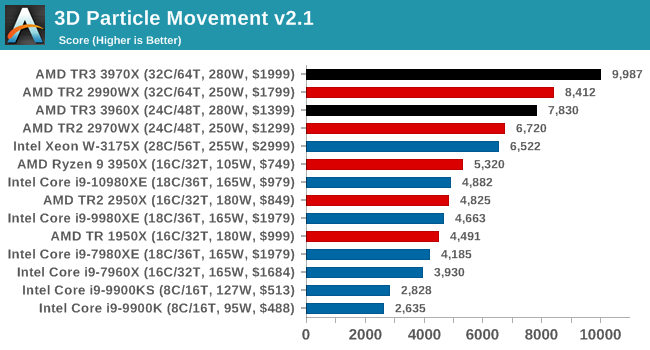
With non-AVX, AMD's floating point units put on a great performance.

This is a workload that can be AVX512 accelerated, and this is the main instance where we can see Intel's CPUs having an advantage.
Dolphin 5.0: Console Emulation
One of the popular requested tests in our suite is to do with console emulation. Being able to pick up a game from an older system and run it as expected depends on the overhead of the emulator: it takes a significantly more powerful x86 system to be able to accurately emulate an older non-x86 console, especially if code for that console was made to abuse certain physical bugs in the hardware.
For our test, we use the popular Dolphin emulation software, and run a compute project through it to determine how close to a standard console system our processors can emulate. In this test, a Nintendo Wii would take around 1050 seconds.
The latest version of Dolphin can be downloaded from https://dolphin-emu.org/
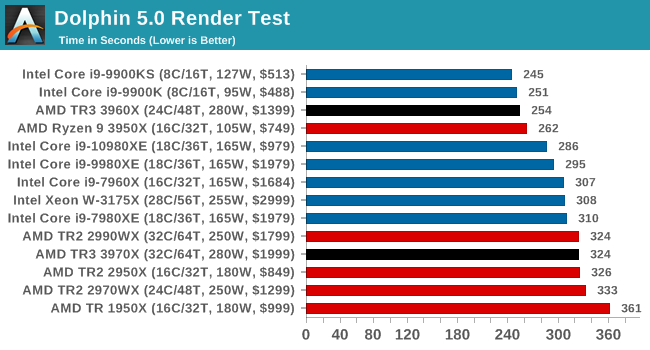
On the single threaded workloads again, and the high frequency mainstream CPUs win here. Interestingly, the 3960X also puts on a really good show, and actually beats our 3950X. Interesting.
DigiCortex 1.20: Sea Slug Brain Simulation
This benchmark was originally designed for simulation and visualization of neuron and synapse activity, as is commonly found in the brain. The software comes with a variety of benchmark modes, and we take the small benchmark which runs a 32k neuron / 1.8B synapse simulation, equivalent to a Sea Slug.
Example of a 2.1B neuron simulation
We report the results as the ability to simulate the data as a fraction of real-time, so anything above a ‘one’ is suitable for real-time work. Out of the two modes, a ‘non-firing’ mode which is DRAM heavy and a ‘firing’ mode which has CPU work, we choose the latter. Despite this, the benchmark is still affected by DRAM speed a fair amount.
DigiCortex can be downloaded from http://www.digicortex.net/
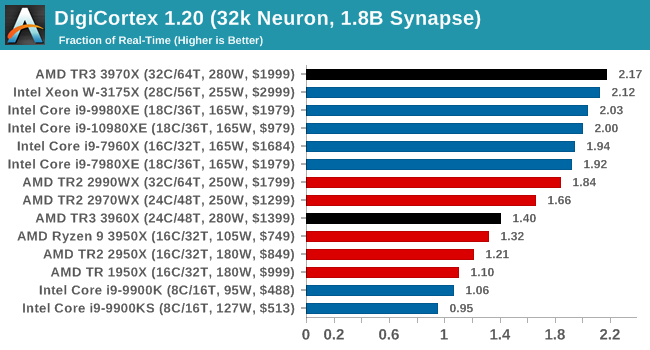
I'm surprised there's that much difference between the 3970X and 3960X here, especially with the 3960X sitting behind the TR2 processors. Might have to re-run this one to double check. But the 3970X puts out a commanding lead.
y-Cruncher v0.7.6: Microarchitecture Optimized Compute
I’ve known about y-Cruncher for a while, as a tool to help compute various mathematical constants, but it wasn’t until I began talking with its developer, Alex Yee, a researcher from NWU and now software optimization developer, that I realized that he has optimized the software like crazy to get the best performance. Naturally, any simulation that can take 20+ days can benefit from a 1% performance increase! Alex started y-cruncher as a high-school project, but it is now at a state where Alex is keeping it up to date to take advantage of the latest instruction sets before they are even made available in hardware.
For our test we run y-cruncher v0.7.6 through all the different optimized variants of the binary, single threaded and multi-threaded, including the AVX-512 optimized binaries. The test is to calculate 250m digits of Pi, and we use the single threaded and multi-threaded versions of this test.
Users can download y-cruncher from Alex’s website: http://www.numberworld.org/y-cruncher/
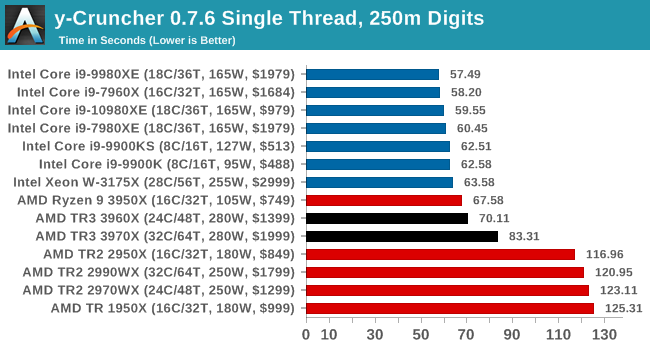
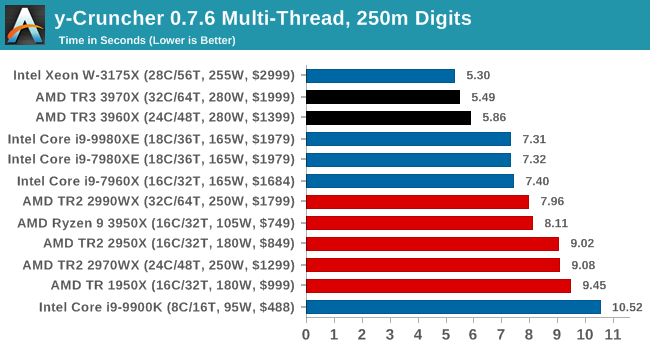
y-Cruncher is also AVX-512 accelerated, however when all the 32 threads come together in MT mode on AVX2, having that many pushes through 18 cores with AVX-512.
Agisoft Photoscan 1.3.3: 2D Image to 3D Model Conversion
One of the ISVs that we have worked with for a number of years is Agisoft, who develop software called PhotoScan that transforms a number of 2D images into a 3D model. This is an important tool in model development and archiving, and relies on a number of single threaded and multi-threaded algorithms to go from one side of the computation to the other.
In our test, we take v1.3.3 of the software with a good sized data set of 84 x 18 megapixel photos and push it through a reasonably fast variant of the algorithms, but is still more stringent than our 2017 test. We report the total time to complete the process.
Agisoft’s Photoscan website can be found here: http://www.agisoft.com/

New records for Photoscan as well.












245 Comments
View All Comments
plonk420 - Monday, November 25, 2019 - link
it may be small, but they're now fighting Intel in that same small market with these Threadrippers, and, well AMD has the winning product in use cases i'm looking at (simultaneous video encoding streams and Blender, with enough cores to do that while gaming).AV1 is currently so slow to encode, i have to split a movie into 8 parts (probably more with one of these Zen2 TRs to get it done quicker) for a doable encode. took about 41-48 hours per part save for the credits to encode at 720p on a 16c32t 1950X
DavyJones - Monday, November 25, 2019 - link
AMD curbstomps Intel at every price point, from $50 all the way to $7000+. How much lower should AMD price their CPU's exactly? Should they give them away for free?And yes, Intel has a vastly larger marketshare. They were on top for well over a decade, & for a large portion of that, AMD was completely irrelevant. Their server marketshare was statistically insignificant just 3 years ago & now they're knocking on the door of 10%. Their stock has skyrocketed in that time. Again... How cheap should AMD go when they have an objectively superior product?
jabber - Tuesday, November 26, 2019 - link
Indeed at the end of the day Dell and HP etc. are taking all the i3/i5 chips the Corporate market can buy.Intel are probably still outselling AMD 10 to 1?
maxxbot - Tuesday, November 26, 2019 - link
I would absolutely bet that more of these TR3 are going to be sold to professionals than consumers, I waited in line for the 3950X yesterday and even for that part half of the people in line were buying it for work.Teckk - Monday, November 25, 2019 - link
In this segment could be, but in laptops Intel is what is selling. AMD needs Zen2 + 7nm thereTEAMSWITCHER - Monday, November 25, 2019 - link
That's my issue... I can't find any of these Threadripper, Ryzen 3950X, or Cascade Lake X in stock anywhere. But I can order 16" MacBook Pro right now and have it here tomorrow. Desktop CPU's are OLD SCHOOL. I would rather have a mobile solution that I can take .. anywhere.Korguz - Monday, November 25, 2019 - link
must be just where you are.. i can go to one store and buy the Threadripper 3960X now, but the 3970x is special order, for the intel 10xx series, not showing anything for these, yetimaheadcase - Monday, November 25, 2019 - link
Did Csutcliff not even look at benchmarks or even look at price difference for a setup?tygrus - Tuesday, November 26, 2019 - link
News of Intel's death have been greatly exaggerated. It would take more than 20 years of bad performance (<20% market share) for Intel to burn it's cash reserves.Oliseo - Tuesday, November 26, 2019 - link
I've seen bigger companies fail faster.